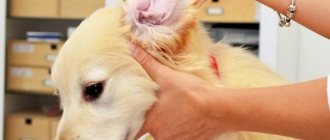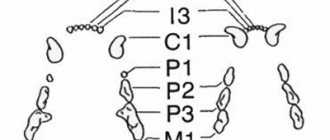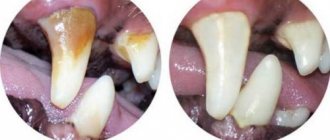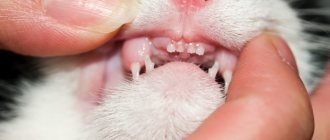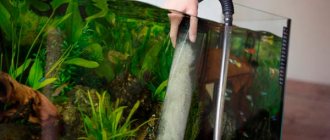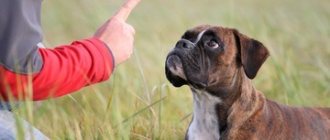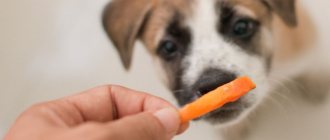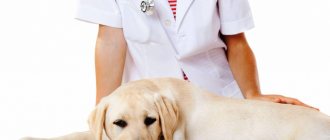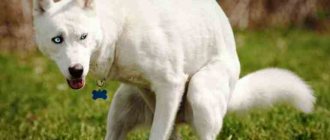Taking responsibility for the life of a four-legged friend, the owner understands that daily care will be required. At the same time, it is often overlooked that the pet’s oral cavity also requires care. If regular hygiene procedures are not performed, dogs can develop a number of dental problems accompanied by pain. Therefore, let's figure out how to properly brush your dog's teeth, what options are available and whether it can be done at home.
Should you brush your dog's teeth at all?
At some point, all dog breeders wonder whether it is necessary to brush their animal’s teeth. There is an opinion that cleansing the mouth occurs automatically, because in the wild, no one performs hygienic procedures for the relatives of the domestic dog and gets rid of tartar.
The answer from professionals is clear - such a procedure is necessary. If the owner ignores such care, it will ultimately lead to major health problems for the pet. The resulting stone will severely injure the animal’s gums, causing severe pain. The dog will quickly stop eating.
Multiplying bacteria will lead to a terrible odor from the mouth and tooth loss. Ultimately, such processes will affect overall health, affecting the functioning of the heart, kidneys and liver.
So, we figured out that oral hygiene is necessary. Can it be done at home or is it better to use the services of a veterinary dentist?
Why brush your dog's teeth
Tartar injures the gums and can also cause exposure of the neck of the tooth.
Some people believe that dogs don't need to brush their teeth. However, this is a misconception. In fact, this procedure is necessary for pets. This is especially true for small ornamental breeds that are not genetically predisposed to life in wildlife.
Remains of food, particles of saliva and bacteria form plaque on your pet’s teeth. If you do not clean the oral cavity in time, tartar appears at the site of the plaque, which is almost impossible to remove without the help of professionals. This condition threatens a number of unpleasant and dangerous consequences for the health of your four-legged friend.
The pet develops an unpleasant putrid odor from the mouth, and the gums bleed. In severe cases, periodontitis and gingivitis develop. It becomes difficult for the dog to chew food, the teeth begin to loosen and fall out.
Improper oral hygiene in a pet can also lead to osteomyelitis, which causes the infection to spread throughout the pet’s circulatory system. Scientists have also proven the connection between dental care and heart disease. Oral problems increase your pet's risk of developing heart disease.
How to get used to cleaning
Before we describe the procedure for brushing teeth, let's talk about how to accustom your friend to this process and how to prepare him.
It is impossible to explain to the animal that such a procedure is simply necessary so that there are no health problems in the future. It will take the dog a long time to get used to the foreign body in the mouth on which the cleaning agent has been applied.
Therefore, learning to brush should begin from a very young age. A puppy can be taught oral hygiene even before the teeth are replaced. In this case, you can only use a brush. He will get used to the procedure itself and will be much easier to handle cleaning with the product.
In addition, it is recommended to carry out the cleaning procedure at a time when the dog is tired. This is possible, for example, after a walk.
There is no need to yell at the dog or force it. Train her gradually. Don't stop trying until your dog gets used to being brushed. You can use special synthetic devices from veterinary pharmacies and stores that clean your teeth.
Why should a dog brush his teeth?
Should you brush your pet's teeth and why should you do it? The answer to this question interests many owners. After all, most are sure that their parents have never cleaned the enamel of the teeth of their purebred dogs, much less the mongrels who guarded the house.
And modern owners are sincerely perplexed: why is this procedure now being so actively promoted by dog handlers and veterinarians?
What is this: a new way to make money from the owner’s naivety or a necessity that has arisen in the modern world?
Let's look at this issue in more detail. There is a simple pattern that led to the need for such manipulation.
- Transferring the dog to dry or canned food. They have a soft texture that adheres firmly to the enamel, lingers between adjacent teeth, or settles between the edge of the gum and the enamel. The dog is not able to remove food debris on its own;
- Such food remains are an ideal breeding ground for the growth and reproduction of pathogenic microorganisms;
- As a result, the dog experiences a daily layering of food debris on top of each other, which becomes the key to the formation of tartar;
- And the presence of pathogenic bacteria contributes to the appearance of an unpleasant odor from the mouth and the development of inflammatory processes in the gums;
- Together, these factors lead to an intolerable “aroma” from the dog’s mouth, and the risk of tooth loss significantly increases long before the animal’s physiological old age.
It is possible to avoid such a sad development of events with a timely and comprehensive approach to solving this problem. This includes regular teeth cleaning and visiting a specialist to examine the condition of the oral cavity.
For skeptical owners, we remind you: in nature, a dog behaves like a predator. Therefore, it is not porridge, dry granules or canned food that it regularly receives as food, but is forced to hunt and chew bones.
In essence, this is a mechanical cleansing of enamel, which is an analogue of classical teeth brushing. And the amount of food (as well as the frequency of its intake) in stray dogs is such that salivary enzymes have time to dissolve the remaining food in the oral cavity.
You may be interested in our article: Tartar and plaque in dogs. It's easier to prevent than to treat
Step-by-step instruction
So, the dog is accustomed to oral hygiene. However, each time it is better to adhere to a certain algorithm so that the dog is calmer:
- Prepare all the items necessary for the procedure and let the animal sniff them. Having felt familiar smells, the dog will not worry and will allow the procedure to be carried out calmly;
- Hold the dog's mouth with one hand and lift the dog's lip with the other. First, run your finger over the animal's teeth and gums. This way you will prepare him for the procedure and determine his mood;
- Then pick up the brush. To brush your teeth, you can use a human toothbrush or buy a special one. There is not much difference between them. If the pet does not show dissatisfaction, brush each tooth sequentially from the outside, moving in one direction;
- Then move on to brushing your teeth from the inside. To open the mouth more, you need to press a little with your hand. If the dog is calm, carry out the procedure to the end. If it doesn’t let you finish, you don’t have to brush your teeth from the inside. They are cleaned quite well by the dog's tongue.
- During the procedure, you need to talk to your pet using a calm tone and laudatory intonations.
The cleaning itself should not take long, just a few minutes. Try to make gentle movements so as not to injure your gums. If the procedure is associated with pain, he will no longer allow you to perform it.
How to train a dog to brush its teeth
No animal will tolerate the rough stuffing of an object into its mouth. The dog is no exception. It is necessary to develop the habit of brushing your pet's teeth from the age of the puppy. Dip your finger, for example, in chicken broth and stick it in the puppy's mouth. Repeat several times during the day until the pet gets used to the fact that the owner’s fingers periodically end up in its mouth.
It is recommended to touch the dog’s mouth with your hand and other objects during the game. After some time, the pet will understand that there is no danger in the hands of the owner. He will stop reacting negatively to the brush in his mouth.
The training process cannot be carried out during illness and heat.
Before and after the procedure, the dog should receive praise and treats.
How to brush teeth
If the owner plans to carry out the cleaning procedure himself, then he should use only a special paste for dogs. You cannot brush your pet's teeth with toothpaste intended for humans. The smells of human products are too strong for animals. In addition, the dog will inevitably swallow the product, which will lead to digestive upset.
Depending on the breed and size of the animal, you can choose a special brush in the store. Pastes are produced both preventative and therapeutic, specialized - for tartar.
For owners who have problems with cleaning, special products are produced that do not require a brush: gels, sprays. Simply apply them to the animal's teeth and they will do their job.
How to brush your dog's teeth at home: step-by-step instructions
It is advisable to make brushing your teeth a fun activity that will entertain your dog and lift his spirits.
You can take care of your pet’s oral cavity yourself at home. However, it is important to know how to carry out the procedure correctly and by what means.
Cleaning your four-legged friend’s teeth consists of several stages:
- Let your pet smell the paste applied to a brush or finger wrapped in gauze.
- Carefully open the jaw and lift the animal's upper lip, first simply rub it over the teeth and gums.
- Brush your teeth one at a time from the outside, moving in one direction.
- If the pet does not resist, move to the inside of the teeth. This area requires less attention as the dog cleans the inside of the tooth with its tongue.
- Reward your pet with a treat.
If the dog resists too much, do not refuse the procedures. In this case, you will have to turn to professionals. The help of veterinarians will also be needed in advanced cases, when tartar has formed or the animal’s gums bleed profusely during the procedure.
In addition, even with timely home care, professional cleaning using special equipment is recommended once every two years.
What can you use instead of pasta?
If you don’t have a special toothpaste on hand, you can use other products. Please note that you cannot use tooth powder or baking soda. Regular toothpaste is too aggressive for an animal, even for children.
For such purposes, you can use diluted hydrogen peroxide. Activated carbon, chlorhexidine, tomato paste. To do this, wrap the finger in a bandage, soak it in the product and clean the teeth.
How to brush your teeth correctly
The pet reacts normally to the periodic appearance of fingers in the mouth, so it is recommended to begin traditional cleaning.
- A simple option is to wrap your finger in a bandage, preferably 3-4 layers. Next, apply a special paste and rub your teeth with light movements. When brushing, do not apply force or press hard for fear of scratching the enamel and damaging your gums.
- If the procedure is being performed for the first time, it may not be possible to clean all the teeth in one time. Long-term brushing is tiring for a dog. Perform the manipulation in a series of techniques.
- There is no need to clean the inside of your pet's teeth. The dog can easily clean it on its own.
- It will be necessary to create an environment (perhaps in the form of a game) so that the animal perceives the procedure easily. There is no need for cleaning to be associated with unpleasant sensations. During the process, it is recommended to speak kindly to the animal and praise it.
You should brush your teeth at least 2 times a week. In total, cleaning does not take too long, taking 10 minutes. After you have brushed your dog's teeth, carefully examine the oral cavity. If you notice that your pet's gums are bleeding, treat with peroxide.
Gradually, the dog will begin to accept the cleaning process quite peacefully, as a matter of course, and the owner will get the hang of brushing the pet’s teeth correctly and carefully. Try replacing your own finger with a small baby brush. Or buy a special copy for dogs at a pet store.
How often to clean
How many times should you clean?
At home
At home - twice a week. During breaks, it is better to give your pet various cleansing items: meat bones, specialized bones (synthetic and edible).
The rest of the time you need to carefully monitor the condition of the mouth. If bleeding occurs, rinse with chlorhexidine; if it persists, contact a veterinarian.
In the clinic
Please note that cleaning your home will not completely remove all dirt. Therefore, the owner can use the service at the veterinary clinic - ultrasonic cleaning.
The procedure is performed without anesthesia and is painless. Although, to avoid stress, light anesthesia can be used. The difference between the condition of the dog’s teeth “before and after” is noticeable. A good clinic will show you this in a photo.
How often should you use ultrasonic cleaning? Your pet should be brought to the clinic for examination once or twice a year. Based on the results of examining the mouth, the doctor will recommend cleaning.
How often should this be done
Before brushing the teeth, you need to sit the dog down, massage and stroke its face, establish contact and eliminate fear
If a person needs to brush their teeth 1-2 times a day, then a pet does not need such frequent hygiene procedures. This is explained by the peculiarity of the structure of the jaw. A dog's fangs are not as close as a person's, and therefore pieces of food do not linger in the mouth.
The best option is to clean your animal’s mouth at least once a week. For small breed dogs, it is advisable to carry out the procedure more often - every three days. Such animals are especially prone to the formation of tartar.
Considering that an adult dog has 42 teeth, and it is recommended to spend approximately 10 seconds cleaning each one, the entire procedure will take no more than 7 minutes. Isolating them is quite simple, and the reward will be a healthy pet.
How to brush small dogs
Separately, it should be noted situations when small breeds need to be cleaned: Yorkies or Chihuahuas, Spitz and the like.
The teeth of such dogs are less cleaned than those of larger dogs. As a rule, owners do not give dry and hard foods to their pets. However, the condition of such a dog’s teeth is very important not only because of its health, but also because of its high exhibition activity.
The cleaning procedure is no different from those performed on other dogs. In addition, you can use special dry food, or soak dry food in tomato juice.
How often should you brush your dog's teeth?
Not all owners can independently and immediately determine how often they need to care for their dog’s teeth. Veterinarians recommend carrying out the procedure at least 2 times a week.
However, daily prevention of the formation of plaque and stone is optimal if the animal is prone to the appearance of such. This applies to breeds with a predisposition to dental disease and older pets.
You cannot refuse to treat the oral cavity if the dog is stubborn. You need to show patience and perseverance so that he begins to perceive the care procedure as a necessary ritual.
